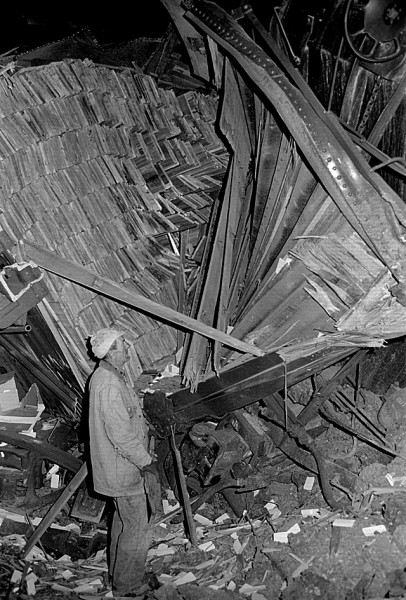 Twenty-seven railroad cars squashed together in a massive pileup Monday morning (March 7, 1966) about a mile north of Neely’s Landing. Two crew members were hurt and two workers were injured later during the clean-up operations, the Missourian story said.
Twenty-seven railroad cars squashed together in a massive pileup Monday morning (March 7, 1966) about a mile north of Neely’s Landing. Two crew members were hurt and two workers were injured later during the clean-up operations, the Missourian story said.
“It’s one of the worst train wrecks I’ve ever seen,” a railroad worker of 44 years commented.
Frisco on regular run
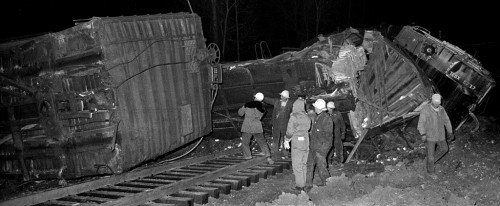 The 76-car Frisco freight train was on its daily St. Louis-to-Memphis run when the cars in the middle derailed almost directly in front of the main cut of the Westlake Rock Quarry, a 200-foot bluff to the west. The Mississippi River was about 150 feet to the east, but no cars went into the river.
The 76-car Frisco freight train was on its daily St. Louis-to-Memphis run when the cars in the middle derailed almost directly in front of the main cut of the Westlake Rock Quarry, a 200-foot bluff to the west. The Mississippi River was about 150 feet to the east, but no cars went into the river.
Conductor and brakeman injured
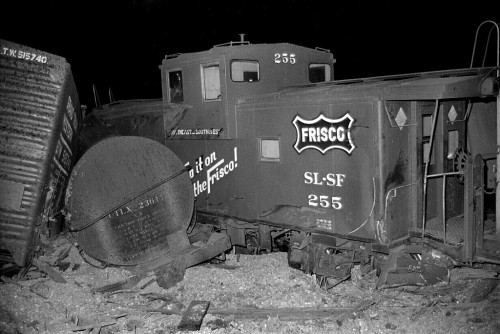 Engineer J.H. Davenport lost contact with his crew after the pileup. He found that the conductor, A.L.Bailey, and the rear brakeman, R.L Becker, were injured and “shook up.” He phoned for help from the home of Sylvester Hitchcock at Neely’s Landing. The two injured crewmen were taken to the Frisco Hospital in St. Louis. Neither was seriously hurt.
Engineer J.H. Davenport lost contact with his crew after the pileup. He found that the conductor, A.L.Bailey, and the rear brakeman, R.L Becker, were injured and “shook up.” He phoned for help from the home of Sylvester Hitchcock at Neely’s Landing. The two injured crewmen were taken to the Frisco Hospital in St. Louis. Neither was seriously hurt.
Massive cranes came from St. Louis and Memphis
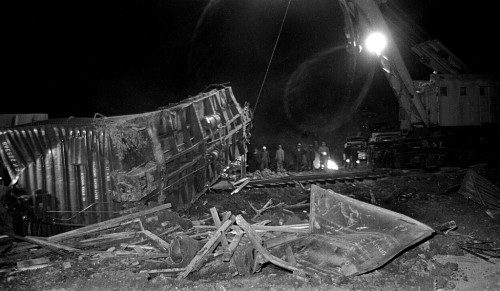 Two wrecker crews worked with giant cranes mounted on railroad flatcars to clear the tracks. A crew from Memphis, with a 250-ton crane, worked the wreck from the south. A St. Louis crew, working with a slightly smaller crane attacked from the north.
Two wrecker crews worked with giant cranes mounted on railroad flatcars to clear the tracks. A crew from Memphis, with a 250-ton crane, worked the wreck from the south. A St. Louis crew, working with a slightly smaller crane attacked from the north.
Bulldozer shoved, pushed and rammed
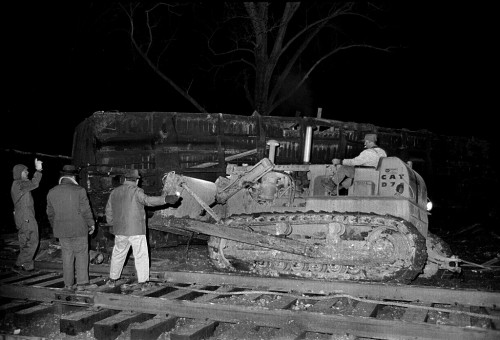 Gerald Ford of Neely’s Landing used a bulldozer to help push the freight cars off the tracks. As the steel cable on the crane pulled one end of the cars, the dozer shoved, pushed and rammed the other end.
Gerald Ford of Neely’s Landing used a bulldozer to help push the freight cars off the tracks. As the steel cable on the crane pulled one end of the cars, the dozer shoved, pushed and rammed the other end.
What caused it?
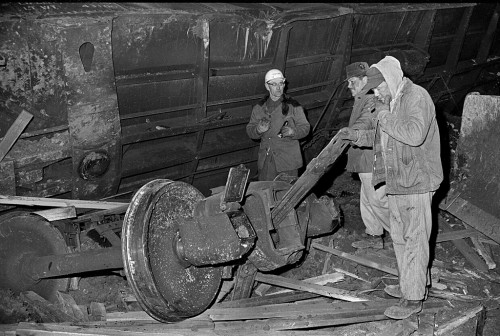 It was working this wreck that I stumbled onto a technique that came in handy over the years. Nobody would comment on the cause of the derailment, so I tried getting the workers aside and asked, “You’ve seen a lot of these things. When you’ve pulled apart ones that looked like this one, what did you find?”
It was working this wreck that I stumbled onto a technique that came in handy over the years. Nobody would comment on the cause of the derailment, so I tried getting the workers aside and asked, “You’ve seen a lot of these things. When you’ve pulled apart ones that looked like this one, what did you find?”
The engineer said he thought the cause might have been a spreading of the rails or a break in the rails. One of the crewmen said that one of the wheels might have frozen and jumped the tracks.
Cable whipped back on workmen
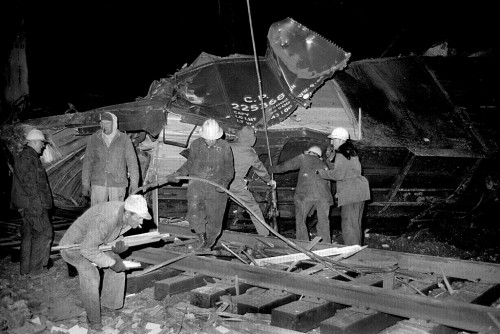 Two crewmen were injured when a cable whipped back striking about six workmen and catching the legs of two of the men.
Two crewmen were injured when a cable whipped back striking about six workmen and catching the legs of two of the men.
I learned from experience to be wary of cables. One of the first things Dad taught me when I was a kid hanging around his job sites was to always step on, not over, a cable on the ground. That way you’d be thrown to the side instead of being cut in half if someone suddenly took up the slack without warning. I saw enough tow cables go whipping around to always stay a cable-length away when they were under load.
It was a cold night
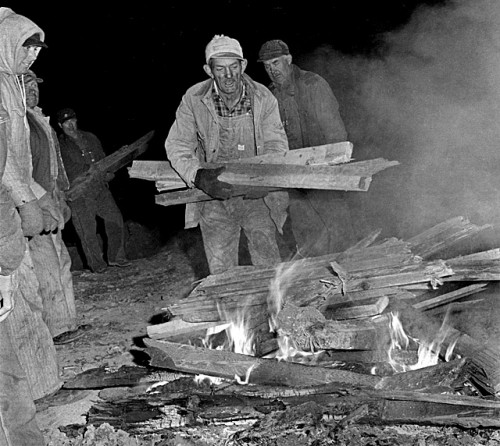 This must have been one of those nights when Frony said, “Let the Kid handle it.”
This must have been one of those nights when Frony said, “Let the Kid handle it.”
I was going to comment that we didn’t have any access problems at the scene, but the last paragraph of the story says that a Frisco official grabbed a Missourian photographer (me) as he was taking a picture of the wreckage. He warned the photographer and a Missourian reporter not to get too close. Another reporter who did not have a press card was told to leave.
Frisco was better than the B&O
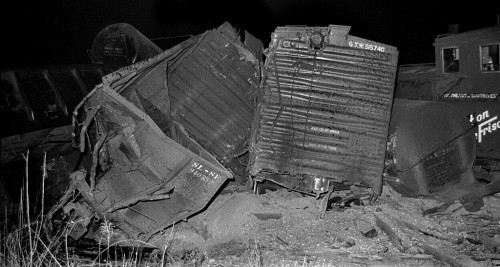 That’s still better than the treatment I was used to getting when the B&O Railroad would pile up a train in southern Ohio. Their railroad bulls were of the ilk and era of the days when hobos were rousted from the trains by clubs and worse. To add to the problem, they had law enforcement powers and were quick to threaten you with arrest for trespassing on their right-of-way. Derailments were common because their tracks were in miserable shape, with rotted ties and spikes that were loose or missing.
That’s still better than the treatment I was used to getting when the B&O Railroad would pile up a train in southern Ohio. Their railroad bulls were of the ilk and era of the days when hobos were rousted from the trains by clubs and worse. To add to the problem, they had law enforcement powers and were quick to threaten you with arrest for trespassing on their right-of-way. Derailments were common because their tracks were in miserable shape, with rotted ties and spikes that were loose or missing.
I thought I had them when a trainload of new automobiles piled up south of Athens, Ohio. Before I headed to the scene, I stopped by the county courthouse to see who owned the land alongside the track. I called the farmer to ask if I could cut across his field and shoot the wreck from his property. “Sure,” he said. “You’re welcome.” Then, just as I was starting to put the phone down with a sly smile on my face, he finished his sentence. “You do remember, don’t you, that the Hocking River is flooding. You’re going to have to be about nine feet tall if you’re going to stand there.” Drat!
Train wreck photo gallery
Some of these images are redundant, but I figure Keith Robinson and his train buff buddies will find details in them that the rest of us will miss. Click on any photo to make it larger, then click on the left or right side to move through the gallery.

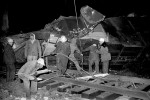



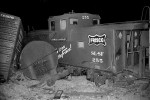




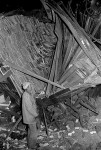

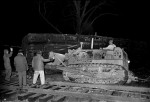
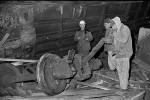
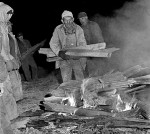
Very clever, pulling the workers aside and asking that question. Well done.
Worker bees always want to help other worker bees.
Tactic Two was to say, “Ah, man, I just got this job. The boss isn’t going to be happy if I don’t come back with SOMETHING.”
Ken, thanks for the gift! I can see that none of the Frisco modelers will be able to use 2 bay hopper #94038 after March 7, 1966. Same applies to a number of other cars. This is the stuff us train goobers drool over.
Wow that was unusual. I just wrote an incredibly long comment but after I clicked submit my comment didn’t
show up. Grrrr… well I’m not writing all that over again.
Regardless, just wanted to say fantastic blog!
I was going to tell you to press Ctrl-F5 to refresh your browser to show new comments, but, you are right. It’s not there. It didn’t go into the spam bucket, either.
The only explanation I can give you is that the site has been running extraordinarily slow today, which is surprising, because it was moved to a much faster server. All I can figure is that maybe the zombies who attack the blog have merely increased the rate of their attacks to match the speed increase.
Anyway, you might have written your post, hit Send, then exited the page before it was actually saved. Sorry about that.